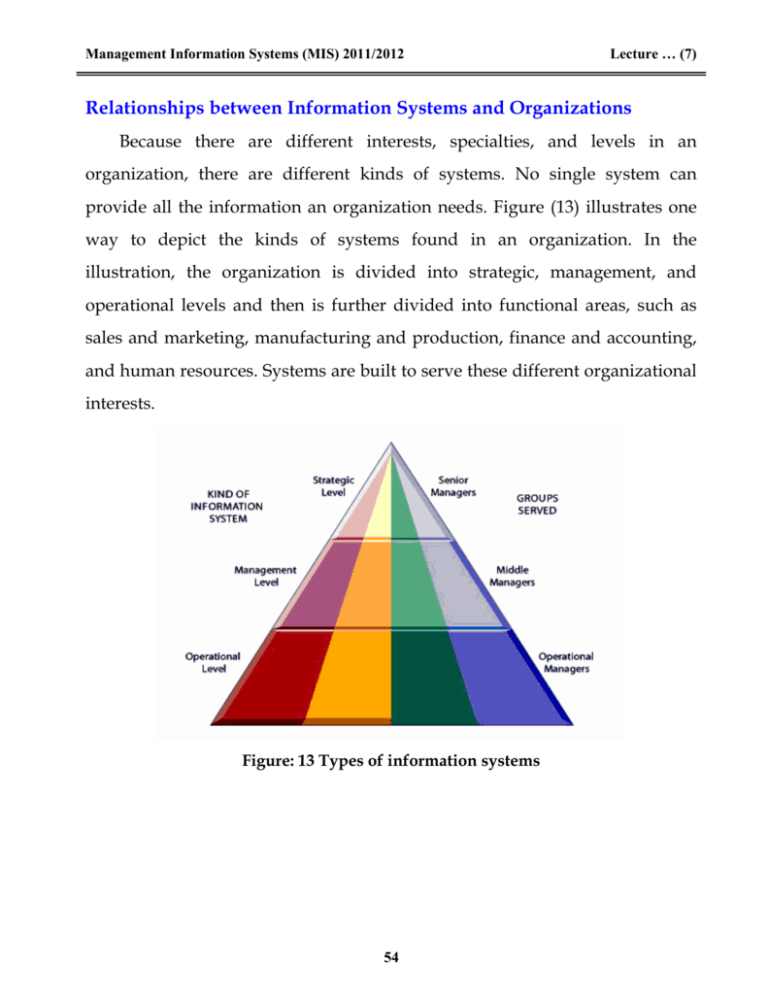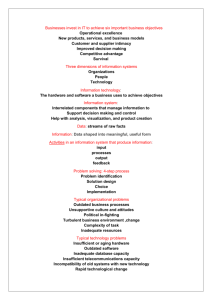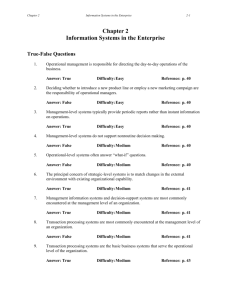MIS & Organizations: Information Systems Lecture Notes
advertisement

Management Information Systems (MIS) 2011/2012 Lecture … (7) Relationships between Information Systems and Organizations Because there are different interests, specialties, and levels in an organization, there are different kinds of systems. No single system can provide all the information an organization needs. Figure (13) illustrates one way to depict the kinds of systems found in an organization. In the illustration, the organization is divided into strategic, management, and operational levels and then is further divided into functional areas, such as sales and marketing, manufacturing and production, finance and accounting, and human resources. Systems are built to serve these different organizational interests. Figure: 13 Types of information systems 54 Management Information Systems (MIS) 2011/2012 Lecture … (7) Different Kinds of Systems Three main categories of information systems serve different organizational levels: operational-level systems, management-level systems, and strategic-level systems. • Operational-level systems: support operational activities by keeping track of the elementary activities and transactions of the organization, such as assigning employees to tasks and recording the number of hours they work, or placing a purchase order. Operational activities are short-term in nature. The information systems that support them are mainly. Operational systems are used by supervisors (first-line managers), operators, and clerical employees. The principal purpose of systems at this level is to answer routine questions and to track the flow of transactions through the organization. How many parts are in inventory? What happened to Mr. Williams’s payment? To answer these kinds of questions, information generally must be easily available, current, and accurate. Examples of operational-level systems include a system to record bank deposits from ATM (Automatic Teller Machines) or one that tracks the number of hours worked each day by employees on a factory floor. • Management-level systems: serve the monitoring, controlling, decisionmaking, and administrative activities of middle managers. The principal question addressed by such systems is this: Are things working well? Management-level systems typically provide periodic reports rather than instant information on operations. Some management-level systems 55 Management Information Systems (MIS) 2011/2012 Lecture … (7) support no routine decision making. They tend to focus on less-structured decisions for which information requirements are not always clear. These systems often answer “what-if” questions: What would be the impact on production schedules if we were to double sales in the next month? What would happen to our return on investment if a factory schedule were delayed for six months? Answers to these questions frequently require new data from outside the organization, as well as data from inside that cannot be easily drawn from existing operational-level systems. Management-level systems are broader in scope than operational-level systems, but like operational systems, they use mainly internal sources of data. They provide the types of support shown in Table 4. Table: 4 Supports provided by MIS 56 Management Information Systems (MIS) 2011/2012 Lecture … (7) • Strategic-level systems: help senior management address strategic issues and long-term trends, both in the firm and in the external environment. Strategic activities are basically decisions that deal with situations that significantly may change the manner in which business is done. Traditionally, strategic decisions involved only long-range planning. A long-range planning document traditionally outlines strategies and plans for the next five or even 10 years. From this plan, companies derive their shorter-range planning, budgeting, and resource allocation. In the digital economy, the planning period has been dramatically reduced to one or two years, or even months. 57 Management Information Systems (MIS) 2011/2012 Lecture … (7) Transaction Processing Systems Transaction processing systems (TPS's) were among the earliest computerized systems. Their primary purpose is to record, process, validate, and store transactions that take place in the various functional areas of a business for future retrieval and use. Transaction processing systems are cross-functional information systems that process data resulting from the occurrence of business transactions, such as sales, purchases, deposits, withdrawals, refunds, and payments. A TPS is also acts as main link between the organization and external entities, such as customers' suppliers, distributors, and regulatory agencies Transaction processing systems serve the operational level of the organization. It is a computerized system that performs and records the daily routine transactions necessary to manage business; they serve the organization’s operational level. The principal purpose of systems at this level is to answer routine questions and to track the flow of transactions through the organization. Examples are hotel reservation systems, payroll, employee record keeping, and shipping. At the operational level, tasks, resources, and goals are predefined and highly structured. The decision to grant credit to a customer, for instance, is made by a lower level supervisor according to predefined criteria. All that must be determined is whether the customer meets the criteria. Figure (14) depicts a payroll TPS, which is a typical accounting transaction processing system found in most firms. A payroll system keeps track of the money paid to employees. The master file is composed of discrete pieces of information (such as a name, address, or employee number) called data elements. Data are keyed into the system, 58 Management Information Systems (MIS) 2011/2012 Lecture … (7) updating the data elements. The elements on the master file are combined in different ways to make up reports of interest to management and government agencies and to send paychecks to employees. These TPS can generate other report combinations of existing data elements. Figure: 14 A symbolic representation for a payroll TPS A payroll system is a typical accounting TPS that processes transactions such as employee time cards and changes in employee salaries and deductions. It keeps track of money paid to employees, withholding tax, and paychecks. 59 Management Information Systems (MIS) 2011/2012 Lecture … (7) Types of Transaction Processing System (TPS's) 1. On-line system: involves a direct connection between operator and the TPS program. They provide immediate result and used to process a single transaction at a time. Ex: an order arrives by telephone call; it is processed at that moment and the result are produced. 2. Batch-processing system: This is a second type of TPS, where transactions are grouped together and processed as a unit. Example: cheque processing system in a bank. Types of Transactions: 1. Internal Transactions: Those transactions, which are internal to the company and are related with the internal working of any organization. For example Recruitment Policy, Promotion Policy, Production policy etc. 2. External Transactions: Those transactions, which are external to the organization and are related with the external sources, are regarded as External Transaction. For example sales, purchase etc. TPS Properties: 1. Consistency: The transaction is a correct transformation of the state. This means that the transaction is a correct program. 2. Isolation: Even though transactions execute concurrently, it appears to the outside observer as if they execute in some serial order. Isolation is required to guarantee consistent input, which is needed for a consistent program to provide consistent output. 60 Management Information Systems (MIS) 2011/2012 Lecture … (7) 3. Reliability: TPS system is designed to ensure that all transactions are entered in sequential and systematic manner. 4. Standardization: Transactions must be processed in the same way each time to maximize efficiency and effectiveness. 5. Controlled Access: Since TPS also contains confidential matters or data; it acts as powerful tool for the organization. Hence access must be restricted. Objectives (Goals) of TPS 1. Process data generated by and about transactions. 2. Maintain a high degree of accuracy. 3. Ensure data and information integrity and accuracy. 4. Produce timely documents and reports. 5. Increase labor efficiency. 6. Help provide increased and enhanced service. 7. Help build and maintain customer loyalty. 8. Achieve competitive advantage. Major Characteristics of TPS 1. TPS handles data which shows the results of various activities on historical basis i.e., activities which have already happened. 2. It is relevant to all functional areas inside organization i.e. (production, marketing, finance and human resources) because each area has some kind of transaction. 3. TPS helps to assess the organizational performance. 4. The sources of data are mostly internal, and the output is intended mainly for an internal audience. 61 Management Information Systems (MIS) 2011/2012 Lecture … (7) 5. The TPS processes information on a regular basis: daily, weekly, monthly, annually etc. 6. It provides high processing speed to handle the high volume of data. 7. Input and output data are structured (i.e., standardized). 8. A high level of accuracy, data integrity, and security is needed which is provided by TPS. Transaction Processing Activities 1. Data collection: Capturing data necessary for the transaction. 2. Data editing: Check validity and completeness of data. 3. Data correction: Correct the wrong data. 4. Data manipulation: Calculate, summarize, Process data. 5. Data storage: Update transactions (on Databases). 6. Document production and reports: Create end result reports. O rig in a l D a ta D a ta C o lle c tio n D a ta B a d D a ta D a ta E d itin g G o o d D a ta C o r re c tio n D a ta M a n ip u la tio n D a ta TPS S to ra g e Docum ent P ro d u c tio n R e p o rts Figure 15: Transaction Processing Activities 62





